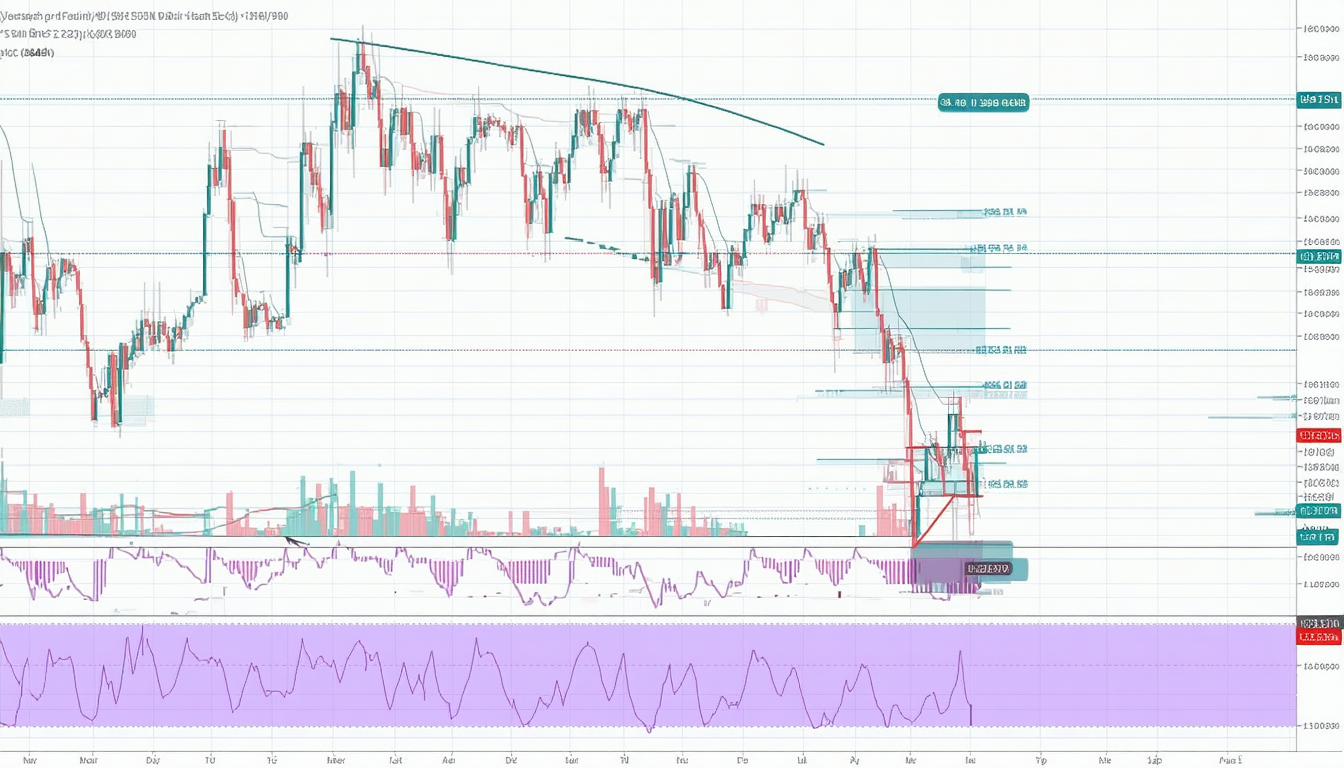Introduction: The Challenge and Stakes of Tracking Bitcoin Price
Whether you’re a dedicated crypto investor or simply crypto-curious, the true value and movement of bitcoin price carries significant weight. Each shift, spike, and correction opens opportunities—as well as risks—that can impact both portfolios and perceptions of the whole digital asset sphere. Yet, with headlines often sensationalizing swings and technical jargon complicating matters, understanding bitcoin price in a practical, actionable way remains elusive for many. This article promises clear interpretation: through live chart insights, value trend analysis, and market context, you’ll gain reliable guidance to make informed decisions around bitcoin price.
Defining Bitcoin Price and Its Relevance in Today’s Market
At its core, “bitcoin price” refers to the current median transactional value of one bitcoin across major global exchanges, commonly quoted in US dollars. Unlike fiat currencies controlled by central authorities, bitcoin’s price is determined by open market trading: a dance of demand, supply, speculation, and macroeconomic influence. In 2021, bitcoin reached an all-time high near $69,000 before undergoing notable corrections, illustrating both potential and volatility (CoinMarketCap, 2022).
Across financial media and investment circles, bitcoin price is tracked closely as a signal for broader crypto market sentiment and as an indicator of adoption momentum. Institutions, from Wall Street funds to multinational corporations, now allocate or observe bitcoin in portfolio strategies, cementing its place as a modern financial asset.
Why Bitcoin Price Dynamics Matter to Readers
For investors, traders, or those considering entry, the bitcoin price is a direct measure of opportunity and risk. Small percentage shifts can mean substantial dollar gains or losses, especially given bitcoin’s historical volatility. Moreover, understanding price action aids in setting realistic profit targets, stop-loss orders, or evaluating whether to hold, buy more, or exit positions. For non-investors, price trends often serve as a barometer for potential business integration, fintech innovation, or regulatory developments affecting the broader economy.
A Practical Framework for Navigating Bitcoin Price Movements
Market participants must move beyond headlines and develop a robust, disciplined approach to analyzing and reacting to bitcoin price movements. Here’s a strategic framework to guide confident, evidence-based decisions:
Pillar 1: Monitor Real-Time Charts and Key Indicators
Begin by familiarizing yourself with a reliable bitcoin live chart. Track timeframes relevant to your objectives—daily for short-term, weekly or monthly for long-term perspectives. Focus on key metrics such as:
- Price levels (support and resistance)
- Volume changes
- Moving averages (e.g., 50-day, 200-day)
- Relative Strength Index (RSI) for overbought/oversold conditions
Interpret these indicators collectively rather than in isolation, as they often provide stronger signals when aligned.
Pillar 2: Assess Fundamental Value Drivers
Beyond price charts, the underlying value of bitcoin is influenced by network activity. Watch for:
- Hash rate trends, as high mining activity implies robust network health
- Active wallet counts and transaction volume, signaling user engagement
- Headline institutional adoption or regulatory changes
Correlate these on-chain signals with price action to test for consistent trends or potential divergences.
Pillar 3: Account for Macro and Sentiment Factors
Crypto markets do not move in a vacuum. Pay attention to:
- Major economic announcements (inflation rates, monetary policy shifts)
- Geopolitical events affecting global risk appetite
- Sentiment indices, such as the “Crypto Fear & Greed Index”
Disciplined tracking helps contextualize abrupt price moves and avoid knee-jerk reactions.
Pillar 4: Apply Risk Management Principles
Set clear entry and exit strategies tailored to your own risk tolerance. Best practices include:
- Defining maximum acceptable loss per trade
- Using stop-loss/take-profit orders
- Diversifying exposure (e.g., not allocating all capital to bitcoin alone)
Such principles prevent emotions from overruling objective analysis.
Tools and Metrics for Ongoing Monitoring
Successful navigation of bitcoin price trends relies on consistently applying robust tools. These include:
- Reputable charting platforms (e.g., TradingView, CoinMarketCap)
- Portfolio trackers integrating bitcoin holdings
- Mobile price alerts
- Regular portfolio performance reviews, ideally on a set schedule
Continual education enhances your ability to interpret new data as the market evolves.
Data & Proof: Key Bitcoin Price Statistics
Essential Market Data and Their Sources
- As of early 2024, bitcoin’s market capitalization remains over $800 billion, cementing its dominance in the crypto asset class (CoinGecko, 2024).
- Volatility in bitcoin price is demonstrated by a 60-day realized volatility of roughly 55%, much higher than major US stock indices in the same period (CryptoCompare, 2023).
- Institutional investment has risen, with over $36 billion in bitcoin-related assets under professional management as of Q1 2024 (Glassnode, 2024).
Implications of the Numbers for Investors and Observers
These statistics illustrate several core realities for anyone watching bitcoin price. High volatility implies both outsized opportunities and risks, requiring agile strategies and strict discipline. The sustained high market cap highlights bitcoin’s entrenched role in both retail and institutional portfolios, supporting its justification as more than a speculative vehicle. Growing institutional inflows suggest confidence in long-term viability—even as price fluctuates sharply in the short term.
Practical Examples of Strategic Engagement with Bitcoin Price
Example A: A Short-Term Trader’s Approach
Consider an active trader who monitored bitcoin price as it approached a previous resistance level near $45,000. By analyzing volume surges and a positive RSI divergence, they timed an entry ahead of a breakout. Using a stop-loss below the support line and a take-profit just under the next resistance, the trader realized a gain of 8% over three trading days—a result achieved by adhering to technical signposts and risk protocols.

Example B: A Long-Term Holder During a Major Correction
In contrast, a long-term investor who acquired bitcoin during a market dip in early 2022, when price briefly touched $35,000, chose not to react emotionally to subsequent volatility. Reviewing on-chain data showing record wallet growth and sustained hash rates, they decided to hold. By early 2024, improved regulatory clarity and renewed institutional buying had pushed prices to new highs, validating their patience and data-driven approach.
Common Mistakes and How to Avoid Them
The allure of rapid gains often leads to errors that can erode capital and confidence. Among the most common missteps:
- Chasing Momentum: Entering trades based purely on rapid upward moves without analysis can lead to buying tops.
- Ignoring Risk Management: Failing to set stop-losses or manage position sizes exposes portfolios to large drawdowns.
- Overreacting to Headlines: Reacting emotionally to news instead of using objective price and on-chain data frequently leads to poor timing.
- Neglecting Fundamental Shifts: Overlooking long-term drivers like network adoption or regulatory changes can result in missed opportunities or unexpected losses.
By establishing evidence-based strategies and continually educating oneself, such pitfalls become avoidable.
Implementation Checklist: Tracking and Responding to Bitcoin Price
- Set up a reliable real-time chart for tracking bitcoin price.
- Define your trading or investing timeframe—day, swing, or long-term.
- Use technical indicators (support/resistance, RSI, moving averages) for insight.
- Monitor on-chain and fundamental signals (hash rate, wallet activity).
- Keep abreast of global financial news impacting sentiment.
- Always set and update risk management rules: stop-losses, diversification.
- Log and review every trade or investment decision for ongoing learning.
Conclusion: Synthesis and Next Steps for Informed Bitcoin Price Analysis
The path to understanding bitcoin price is paved with both opportunity and complexity. By embracing a framework that blends real-time chart analysis, fundamental evaluation, and disciplined risk management, investors and observers sharpen their ability to interpret even the wildest swings. Data underscores both immense volatility and growing institutional confidence, while practical examples show that adapting strategy to context—short-term or long-term—makes all the difference.
To move forward, commit to continual monitoring and education. Establish your analytical toolkit, ground every step in verified data, and remain patient amid market noise. With this approach, the bitcoin price transforms from a confusing headline to a navigable indicator of genuine opportunity.
FAQs
What is the bitcoin price and how is it determined?
Bitcoin price represents the current trading value of one bitcoin on open exchanges, reflecting real-time supply and demand without central authority intervention. It can differ slightly across platforms due to liquidity and market depth.
Why does the bitcoin price fluctuate so much compared to stocks?
High volatility in bitcoin price is driven by speculative trading, lower liquidity compared to traditional assets, and the market’s sensitivity to both news and macroeconomic shifts. This presents both unique opportunities and significant risks for market participants.
How can I track live bitcoin price trends effectively?
Use a reputable live charting platform to monitor bitcoin price, set price alerts, and regularly review both technical and fundamental indicators. This disciplined approach aids in timely and informed decision-making.
Is it safe to invest in bitcoin given its price volatility?
Bitcoin price movements carry inherent risk, so it’s essential to apply strict risk management, diversify across assets, and only invest what you can afford to lose. Long-term holders have historically fared better by focusing on fundamentals.
What tools help analyze bitcoin price for better outcomes?
Technical analysis platforms, on-chain data aggregators, and portfolio trackers provide a comprehensive view of bitcoin price trends, supporting more structured and objective decision-making for both new and seasoned participants.





